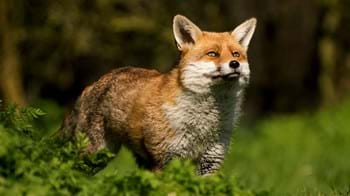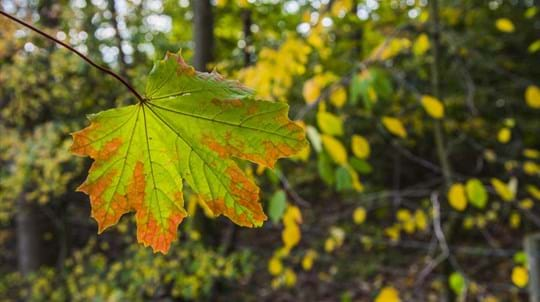
Coed Hafod y Llyn
Maentwrog

Woodland Trust wood
16.57 ha (40.94 acres)
SH648412
Explorer 18
OS Landranger 124
This secluded and ethereal ancient oakwood was once part of an historic estate and slopes gently down to Llyn Mair (Mary’s Lake). A network of paths allows spectacular views over Snowdonia National Park, while steam trains of the iconic Ffestiniog Railway snake around the boundary.
With rare wildlife and an abundance of stunning flora, Coed Hafod y Llyn is the perfect woodland destination for train buffs and nature lovers alike.
Features
- Parking nearby
- Public access
- Autumn colour
- Spring flowers
How to get to Coed Hafod y Llyn
Coed Hafod y Llyn is 1.6km (1 mile) from the village of Maentwrog in Gwynedd, North Wales. The 16.6-hectare (41-acre) site is part of an extensively wooded area which includes the National Nature Reserve and Snowdonia National Park.
Heading north along the A487 towards Porthmadog, ignore the left turn for Maentwrog and Harlech (A496), and instead continue for a further 0.4km (0.25 miles). Then turn right at the following junction, next to the Oakley Arms and signposted for Rhyd (B4410).
Continue until you can see a lake (Llyn Mair) to the left. Coed Hafod y Llyn is located at the back end of the lake. Enter through the Snowdonia National Park picnic area on the left side, just after the lake.
The nearest train station is Penrhyndeudraeth, just over 3km (2 miles) away. There is also a narrow gauge railway station just under a kilometre (0.5 miles) away from the wood at Tan y Bwlch.
Visit National Rail for more information.
The nearest bus stop is next to the Oakley Arms on the A487.
Visit Traveline for more information.
Facilities and access
There are five public entrances to the wood. Two are on either end of the lake, and have no barriers or gates. They are accessed through Snowdonia National Park properties. Three top entrances with wooden vehicle gates are situated where the footpath crosses or goes beneath the Ffestiniog Railway line.
The wood contains a network of well-surfaced and drained paths. These include wide forest roads, an old horse and cart sunken track, and less defined link paths. Paths are not steep and are suitable for most abilities. The most difficult section is the sunken track, which is relatively steep and very wet in the winter months.
There is a Japanese-style stone seat by the Victorian ornamental pond near Llyn Mair, and a naturalistic wooden carved seat near a woodland stream.
There is parking available nearby in the Natural Resources Wales car park.
There is a public toilet behind the bus shelter next to the Oakley Arms on the A487. It is open all year round and has disabled access.
Wildlife and habitats
Animals
Coed Hafod y Llyn is a haven for bird lovers. Look out for the striking orange feathers of the male redstart, the bright yellow breast of the wood warbler, or the small pied flycatcher as it hunts for flies during spring and summer. Keen-eyed bird watchers might just catch a glimpse of the magnificent osprey, a rare visitor to Wales.
While birds make up most of the population of wildlife at Coed Hafod y Llyn, it is also home to many nocturnal mammals. As dusk falls, the wood comes alive with foxes and badgers, and rare lesser horseshoe bats flit across the darkening sky in search of insects. If you’re very lucky, you may spot the elusive pine marten. Listen for its shrill, cat-like call if you visit during its mating season of July and August.
Trees, plants and fungi
Set in magical upland western oak woods with scatterings of birch, ash and hazel, Coed Hafod y Llyn has a mild, damp climate, ideal for a diverse array of ferns, mosses, liverworts and lichens.
A host of stunning wild flowers bloom in the woods during spring, from glorious bluebells to sweet-smelling honeysuckle, and in summer the lake blooms with water lilies.
Habitats
With shimmering streams, gnarled ancient woodland, ethereal upland oakwoods, rocky ridges and fern-clad gorges, Coed Hafod y Llyn is teeming with a variety of habitats.
Things to do at Coed Hafod y Llyn
History
Once part of the Tan y Bwlch estate, belonging to the Oakeley family, the estate’s grand country house is now home to the Snowdonia National Park Study Centre which offers environmental courses to the public.
Mary's Lake
Llyn Mair (Mary’s Lake) is a Victorian decorative feature said to have been built by William Edward Oakeley for his daughter. As well as an extravagant gift, in 2013 the lake began providing hydro-electric power to Plas and other surrounding villages.
Railways and steam trains
Tan-y-Bwlch railway was developed in 1836 to transport slate from Blaenau Ffestiniog to Porthmadog. Today, the tracks are still used by steam trains.

A lasting legacy
This wood is just one of many to have been protected by gifts in wills, securing it for generations to come. Your legacy gift could also make a real difference to woods, trees and wildlife.
Learn what your gift could meanThings to do at Coed Hafod y Llyn
Walking
Explore the extensive network of paths through a landscape of varied habitats and you’ll come across some perfect picnic spots, such as the little Victorian ornamental pond near the lake. Or, take a rest on one of the decorative carved benches and admire the views.
The wood is also part of a network of woodlands around the National Park study centre at Plas Tan y Bwlch. So, if you've still got plenty of energy after you've fully explored Coed Hafod y Llyn, you can keep on going by connecting with the Dyffryn Maentwrog and Llyn Mair footpath network in the Snowdonia National Park, which includes over 30km (18 miles) of paths.


















































